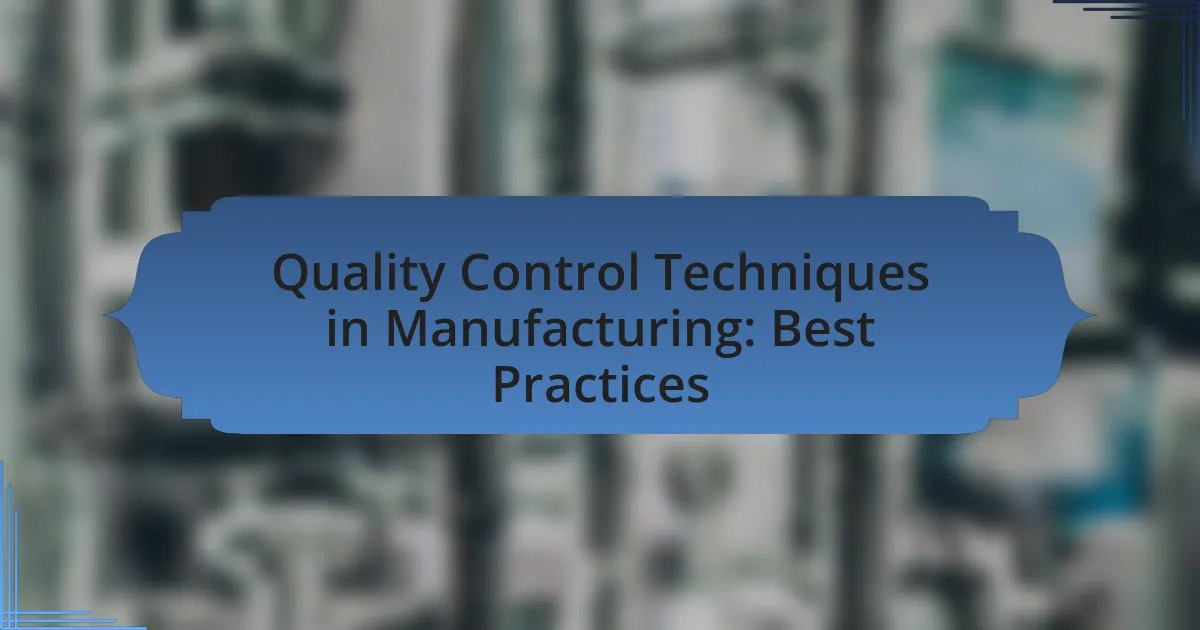Lean manufacturing principles are methodologies designed to minimize waste and maximize productivity in manufacturing processes. This article outlines the core concepts of lean manufacturing, including value identification, value stream mapping, flow, pull, and perfection, and explains how these principles contribute to efficiency improvements. It discusses the practical applications of lean principles across various industries, highlights successful case studies, and addresses common challenges and pitfalls in implementation. Additionally, the article emphasizes the importance of continuous improvement and employee engagement in sustaining lean initiatives, providing best practices for organizations seeking to enhance operational efficiency.
What are Lean Manufacturing Principles?

Lean manufacturing principles are a set of methodologies aimed at minimizing waste while maximizing productivity. These principles include value identification, value stream mapping, creating flow, establishing pull, and pursuing perfection. For instance, value identification focuses on understanding what customers perceive as valuable, which guides the elimination of non-value-adding activities. Value stream mapping visually represents the flow of materials and information, helping to identify areas of waste. Creating flow ensures that production processes run smoothly without interruptions, while establishing pull means producing only what is needed when it is needed, reducing excess inventory. Finally, pursuing perfection involves continuous improvement efforts to enhance processes and eliminate waste. These principles collectively contribute to increased efficiency and effectiveness in manufacturing operations.
How do Lean Manufacturing Principles contribute to efficiency improvements?
Lean Manufacturing Principles contribute to efficiency improvements by systematically eliminating waste and optimizing processes. These principles focus on value creation for the customer while minimizing resources, time, and effort. For instance, the implementation of Just-In-Time production reduces inventory costs and enhances responsiveness to customer demand, leading to faster delivery times. Additionally, techniques such as Value Stream Mapping identify inefficiencies in workflows, allowing organizations to streamline operations. Research by Womack and Jones in “Lean Thinking” highlights that companies adopting Lean practices can achieve up to 30% reductions in lead times and significant cost savings, validating the effectiveness of these principles in enhancing operational efficiency.
What are the key concepts of Lean Manufacturing?
The key concepts of Lean Manufacturing include value, value stream, flow, pull, and perfection. Value refers to what the customer is willing to pay for, while value stream encompasses all the steps involved in delivering that value. Flow emphasizes the smooth progression of products through the manufacturing process, minimizing delays. Pull signifies producing only what is needed when it is needed, reducing excess inventory. Lastly, perfection is the continuous pursuit of eliminating waste and improving processes. These concepts collectively aim to enhance efficiency and reduce waste in manufacturing operations.
How do these concepts interact to enhance efficiency?
Lean manufacturing principles interact to enhance efficiency by eliminating waste, optimizing processes, and improving product quality. These principles, such as value stream mapping and continuous improvement, work together to streamline operations. For instance, value stream mapping identifies non-value-added activities, allowing teams to focus on essential tasks that contribute directly to customer value. Continuous improvement fosters a culture where employees regularly seek ways to enhance processes, leading to incremental gains in efficiency. Research shows that companies implementing lean practices can achieve up to a 30% reduction in lead times and a 50% decrease in inventory levels, demonstrating the tangible benefits of these interactions in enhancing overall operational efficiency.
Why is Lean Manufacturing important in today’s industry?
Lean Manufacturing is important in today’s industry because it enhances operational efficiency by minimizing waste and optimizing processes. This methodology allows companies to deliver higher quality products at lower costs, which is crucial in a competitive market. For instance, organizations that implement Lean principles can achieve up to a 30% reduction in production costs and a 50% improvement in lead times, as evidenced by case studies from companies like Toyota and Boeing. These improvements not only increase profitability but also enhance customer satisfaction, making Lean Manufacturing a vital strategy for modern businesses.
What challenges does Lean Manufacturing address?
Lean Manufacturing addresses challenges such as waste reduction, process inefficiencies, and quality control. By focusing on eliminating non-value-added activities, Lean Manufacturing enhances operational efficiency and reduces costs. For instance, studies show that companies implementing Lean principles can achieve up to a 30% reduction in lead times and a 50% decrease in inventory levels, demonstrating significant improvements in productivity and resource utilization.
How does Lean Manufacturing impact overall productivity?
Lean Manufacturing significantly enhances overall productivity by eliminating waste and optimizing processes. This methodology focuses on streamlining operations, which leads to reduced cycle times and improved efficiency. For instance, a study by the Lean Enterprise Institute found that companies implementing Lean practices experienced productivity increases of 25% to 50%. By fostering a culture of continuous improvement and empowering employees to identify inefficiencies, Lean Manufacturing not only boosts output but also enhances product quality, further contributing to productivity gains.
What are the core components of Lean Manufacturing?

The core components of Lean Manufacturing are value, value stream, flow, pull, and perfection. Value refers to what the customer is willing to pay for, while value stream encompasses all the steps involved in delivering that value. Flow emphasizes the smooth progression of products through the manufacturing process, minimizing delays. Pull signifies producing only what is needed when it is needed, reducing excess inventory. Lastly, perfection involves continuous improvement to eliminate waste and enhance efficiency. These components collectively aim to optimize processes and increase customer satisfaction.
How does value stream mapping fit into Lean Manufacturing?
Value stream mapping is a critical tool in Lean Manufacturing that helps identify and eliminate waste in processes. By visually representing the flow of materials and information, value stream mapping enables organizations to analyze current processes, pinpoint inefficiencies, and streamline operations. This method aligns with Lean principles by focusing on maximizing value for the customer while minimizing waste, thereby enhancing overall efficiency. Studies have shown that companies implementing value stream mapping can achieve significant reductions in lead times and costs, reinforcing its effectiveness in Lean Manufacturing practices.
What steps are involved in creating a value stream map?
Creating a value stream map involves several key steps: identifying the process to be mapped, gathering data on the current state, mapping the current state, analyzing the current state for waste, designing the future state, and developing an action plan for implementation.
First, the process to be mapped must be clearly defined, focusing on a specific product or service. Next, data collection occurs, which includes measuring cycle times, inventory levels, and lead times. After data collection, the current state map is created, visually representing the flow of materials and information.
Following this, the current state is analyzed to identify areas of waste, such as delays or excess inventory. The future state map is then designed, outlining an improved process with reduced waste and enhanced efficiency. Finally, an action plan is developed to implement the changes necessary to achieve the future state.
These steps are essential for organizations aiming to improve efficiency through lean manufacturing principles, as they provide a structured approach to identifying and eliminating waste in processes.
How does value stream mapping identify waste?
Value stream mapping identifies waste by visually representing the flow of materials and information in a process, allowing teams to pinpoint inefficiencies. This technique highlights areas where delays, excess inventory, and unnecessary steps occur, enabling organizations to focus on eliminating non-value-added activities. Research indicates that value stream mapping can reduce lead times by up to 50% and improve overall process efficiency, demonstrating its effectiveness in waste identification and reduction.
What role does continuous improvement play in Lean Manufacturing?
Continuous improvement is fundamental to Lean Manufacturing as it drives the ongoing enhancement of processes, products, and services. This approach, often referred to as Kaizen, emphasizes incremental changes that lead to significant efficiency gains over time. By systematically identifying and eliminating waste, Lean Manufacturing fosters a culture where employees at all levels are encouraged to contribute ideas for improvement. Research indicates that organizations implementing continuous improvement within Lean frameworks can achieve up to a 30% increase in productivity and a 50% reduction in lead times, demonstrating the tangible benefits of this methodology.
What methodologies support continuous improvement?
Methodologies that support continuous improvement include Lean, Six Sigma, and Kaizen. Lean focuses on eliminating waste and enhancing value, which leads to more efficient processes. Six Sigma employs data-driven techniques to reduce defects and improve quality, aiming for near perfection in performance. Kaizen emphasizes small, incremental changes that collectively lead to significant improvements over time. These methodologies are widely recognized in manufacturing and service industries for their effectiveness in fostering a culture of ongoing enhancement and operational excellence.
How can organizations implement continuous improvement effectively?
Organizations can implement continuous improvement effectively by adopting a structured approach such as the Plan-Do-Check-Act (PDCA) cycle. This method allows organizations to systematically test changes, evaluate results, and refine processes. For instance, Toyota, a pioneer in lean manufacturing, utilizes this cycle to enhance production efficiency and reduce waste, demonstrating that iterative testing and feedback lead to significant operational improvements. By fostering a culture of open communication and employee involvement, organizations can ensure that continuous improvement initiatives are embraced at all levels, leading to sustained enhancements in performance and quality.
What are the practical applications of Lean Manufacturing principles?

Lean Manufacturing principles have practical applications in various industries, primarily aimed at reducing waste and improving efficiency. These principles can be applied in manufacturing processes to streamline operations, enhance product quality, and reduce lead times. For instance, the implementation of Just-In-Time (JIT) inventory management minimizes excess stock and reduces holding costs, which has been shown to improve cash flow and operational efficiency. Additionally, the use of Value Stream Mapping helps organizations identify and eliminate non-value-added activities, leading to more efficient workflows. Companies like Toyota have successfully utilized Lean principles to achieve significant reductions in production costs and cycle times, demonstrating the effectiveness of these methodologies in real-world scenarios.
How can Lean Manufacturing be applied in various industries?
Lean Manufacturing can be applied in various industries by streamlining processes, reducing waste, and enhancing productivity. In the automotive industry, for example, Lean principles are utilized to minimize inventory and improve assembly line efficiency, leading to a reduction in production costs and time. In healthcare, Lean methodologies help eliminate unnecessary steps in patient care processes, resulting in faster service delivery and improved patient outcomes. The food industry applies Lean by optimizing supply chain management and reducing spoilage, which enhances overall operational efficiency. Additionally, in the software development sector, Lean practices focus on continuous improvement and rapid delivery, which increases responsiveness to customer needs. These applications demonstrate Lean Manufacturing’s versatility across different sectors, contributing to significant efficiency improvements and cost savings.
What are some successful case studies of Lean Manufacturing implementation?
Successful case studies of Lean Manufacturing implementation include Toyota, Boeing, and Intel. Toyota’s implementation of the Toyota Production System (TPS) revolutionized automotive manufacturing by reducing waste and improving efficiency, leading to a 50% reduction in production time and a significant increase in quality. Boeing applied Lean principles in its 787 Dreamliner project, which resulted in a 30% reduction in production costs and improved delivery times. Intel adopted Lean practices in its semiconductor manufacturing, achieving a 90% reduction in cycle time and a 50% increase in productivity. These examples demonstrate the effectiveness of Lean Manufacturing in enhancing operational efficiency and reducing costs across various industries.
How do different sectors adapt Lean principles to their needs?
Different sectors adapt Lean principles by tailoring methodologies to fit their specific operational challenges and goals. For instance, in manufacturing, companies implement Just-In-Time (JIT) inventory systems to reduce waste and improve efficiency, while in healthcare, Lean practices focus on streamlining patient flow and reducing wait times. The software industry often employs Agile methodologies, which incorporate Lean principles to enhance product development cycles and improve responsiveness to customer feedback. These adaptations demonstrate that Lean principles are versatile and can be customized to meet the unique demands of various industries, ultimately leading to improved efficiency and effectiveness.
What tools and techniques are essential for Lean Manufacturing?
Essential tools and techniques for Lean Manufacturing include Value Stream Mapping, 5S, Kaizen, Kanban, and Just-In-Time production. Value Stream Mapping identifies waste and optimizes processes by visualizing the flow of materials and information. The 5S technique focuses on workplace organization and standardization, enhancing efficiency and safety. Kaizen promotes continuous improvement through small, incremental changes involving all employees. Kanban is a scheduling system that controls the logistical chain from a production point of view, ensuring that inventory levels are maintained efficiently. Just-In-Time production minimizes inventory costs by producing only what is needed when it is needed, reducing waste and increasing responsiveness to customer demand. These tools and techniques collectively contribute to the core principles of Lean Manufacturing, which aim to enhance efficiency and reduce waste in production processes.
What is the 5S methodology and how does it support Lean principles?
The 5S methodology is a systematic approach to workplace organization and standardization that consists of five steps: Sort, Set in order, Shine, Standardize, and Sustain. This methodology supports Lean principles by eliminating waste, improving efficiency, and fostering a culture of continuous improvement. By implementing 5S, organizations can create a clean and organized work environment, which enhances productivity and reduces the time spent searching for tools and materials. The structured nature of 5S aligns with Lean’s focus on maximizing value while minimizing waste, thereby reinforcing the overall goals of Lean manufacturing.
How can Kaizen events drive efficiency improvements?
Kaizen events drive efficiency improvements by fostering continuous, incremental changes in processes. These structured, team-based activities focus on identifying waste, streamlining workflows, and enhancing productivity. For instance, a study by the Lean Enterprise Institute found that organizations implementing Kaizen events reported up to a 30% reduction in cycle times and a significant increase in employee engagement, which directly correlates with improved operational efficiency.
What are the common pitfalls in implementing Lean Manufacturing?
Common pitfalls in implementing Lean Manufacturing include lack of leadership commitment, insufficient training, and failure to engage employees. Leadership commitment is crucial as it sets the tone for the entire organization; without it, initiatives may lack direction and support. Insufficient training can lead to misunderstandings of Lean principles, resulting in ineffective application and resistance to change. Engaging employees is essential because their involvement fosters a culture of continuous improvement; neglecting this can lead to low morale and disengagement from Lean initiatives. These pitfalls are supported by research indicating that organizations with strong leadership and employee engagement see significantly better outcomes in Lean implementation.
How can organizations avoid resistance to change?
Organizations can avoid resistance to change by fostering open communication and involving employees in the change process. Engaging employees early helps them understand the reasons for change and allows them to voice concerns, which can reduce anxiety and opposition. Research indicates that organizations that prioritize employee involvement during transitions experience a 70% success rate in implementing change initiatives, as highlighted in the study “The Change Management Process” by Kotter and Cohen. This approach not only builds trust but also encourages a collaborative environment, making employees feel valued and more likely to embrace new practices aligned with lean manufacturing principles.
What strategies can help sustain Lean initiatives over time?
To sustain Lean initiatives over time, organizations should implement continuous training and development programs for employees. These programs ensure that all team members are well-versed in Lean principles and practices, fostering a culture of continuous improvement. Research indicates that companies with ongoing training see a 20% increase in employee engagement and a 15% reduction in waste, which reinforces the effectiveness of Lean methodologies. Additionally, establishing a system for regular feedback and performance measurement helps identify areas for improvement and maintain momentum in Lean practices. This approach has been shown to enhance operational efficiency by up to 30% in organizations that actively monitor and adjust their Lean strategies.
What best practices should organizations follow for successful Lean Manufacturing?
Organizations should implement continuous improvement, value stream mapping, and employee engagement as best practices for successful Lean Manufacturing. Continuous improvement, or Kaizen, encourages ongoing efforts to enhance processes, which can lead to significant efficiency gains over time. Value stream mapping helps identify and eliminate waste by visualizing the flow of materials and information, allowing organizations to streamline operations effectively. Employee engagement fosters a culture of collaboration and innovation, empowering workers to contribute ideas for process improvements. These practices are supported by numerous case studies, such as Toyota’s production system, which demonstrates the effectiveness of Lean principles in achieving operational excellence and reducing costs.




